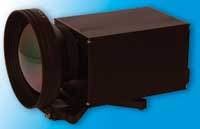Jenoptik offers new infrared camera module
For express visualization or measurement of heat distribution patterns, Jenoptik Laser Optik Systeme GmbH in Jena, Germany, is offering camera modules for infrared spectral operation. The IR-TCM 320 registers two-dimensional heat distributions in real time with a resolution of 320 by 240 pixels. Temperatures between -40 and 2 degrees Celsius can be visualized as thermographs with 90 mK resolution. Standard interfaces such as IEEE 1394 Firewire, S-/C-Video or RS232 are available for integration of the compact module into a broad diversity of OEM applications. Among the available options are: image analysis software, remote camera control and a choice of objective lenses with different focal lengths. A dedicated Software Development Kit (SDK) allows for flexible integration of the IR-TCM 320 into specific custom-application software. Applications of the module include industrial process control and process automation, furnace monitoring, or security installations. For more information contact Jenoptik online at www.jenoptik-los.com
Boeing-led team tracks and targets simulated missile in Airborne Laser ground test
The Boeing Co. Integrated Defense Systems segment in St. Louis, with industry teammates and the U.S. Missile Defense Agency, conducted an Airborne Laser (ABL) ground test on June 6, demonstrating the weapon’s ability to track and target a ballistic missile. During the test at Boeing facilities in Wichita, Kan., the ABL, which operates aboard a modified Boeing 747-400F aircraft, located a simulated boosting ballistic missile target created by a target simulator. After using simulated returns from a surrogate target illuminator laser to track the target, the Airborne Laser used simulated returns from a surrogate beacon illuminator laser to compensate for atmospheric turbulence that ABL’s high-energy laser would encounter in its path to a target. The equipment used in the test is part of the beam control/fire control system, designed and integrated by Lockheed Martin, and the battle-management system developed by Boeing. “The Airborne Laser team is working tirelessly to reach its first 2006 Knowledge Point, in which the two actual illuminators will be installed, integrated and ground-tested in the ABL aircraft,” says Pat Shanahan, vice president and general manager of Boeing Missile Defense Systems. The high-energy laser, which achieved lethal power and run-times in a ground laboratory in December 2005, is currently being refurbished and will be installed in the ABL aircraft in 2007; the program’s first missile shoot-down test is scheduled for 2008. Boeing is the prime contractor for ABL.
DRS Technologies receives Army contract for next-generation thermal weapon sights
The U.S. Army’s Communications-Electronics Command (CECOM) in Fort Monmouth, N.J., acting on behalf of Program Executive Office Soldier awarded DRS Technologies, in Parsippany, N.J., a $14 million order to produce next-generation lightweight Thermal Weapon Sights (TWS II) for U.S. Army ground force applications. For this award, DRS will produce Light Thermal Weapon Sights and Thermal Imaging Modules (TIMs), which will utilize the company’s uncooled infrared technology. Work for this contract will be accomplished by the company’s DRS Sensors & Targeting Systems-Optronics Division in Palm Bay and Melbourne, Fla., and Infrared Technologies Division in Dallas, Texas, and Irvine, Calif. Using advanced microbolometer-based infrared technology, the DRS family of light, medium, and heavy TWS will provide U.S. Army soldiers and armament crews with greater range of threat detection and wider field of view at a reduced cost.




